Work Health and Safety - Desklib
VerifiedAdded on 2022/10/01
|12
|2208
|402
AI Summary
This article discusses work health and safety, key agencies and stakeholders, identification of risk and hazards, assessment of risk, regulation of risk, documentation procedure, and more. It also provides recommendations for improving workplace safety. The article is relevant for students and professionals in the field of occupational safety and health.
Contribute Materials
Your contribution can guide someone’s learning journey. Share your
documents today.
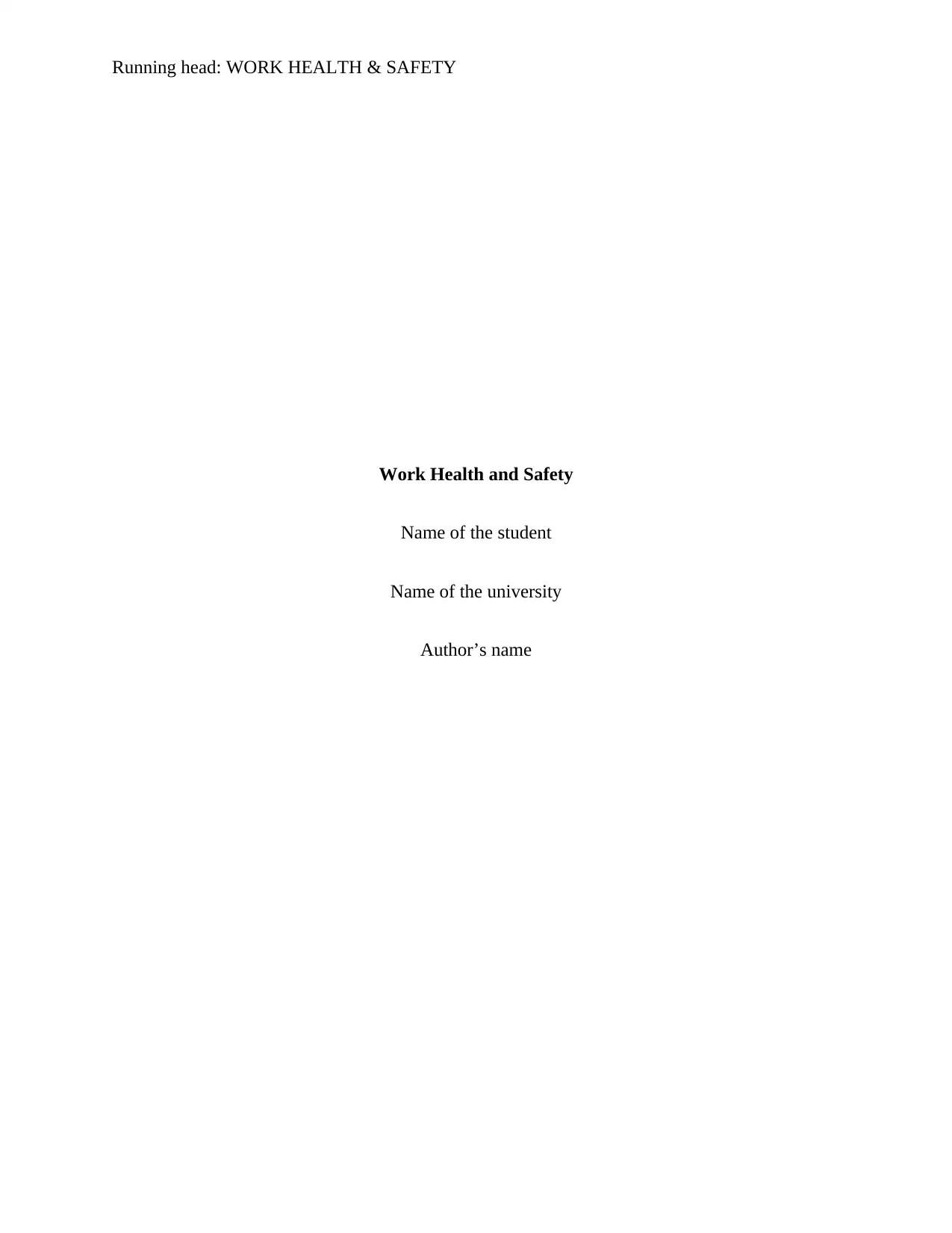
Running head: WORK HEALTH & SAFETY
Work Health and Safety
Name of the student
Name of the university
Author’s name
Work Health and Safety
Name of the student
Name of the university
Author’s name
Secure Best Marks with AI Grader
Need help grading? Try our AI Grader for instant feedback on your assignments.
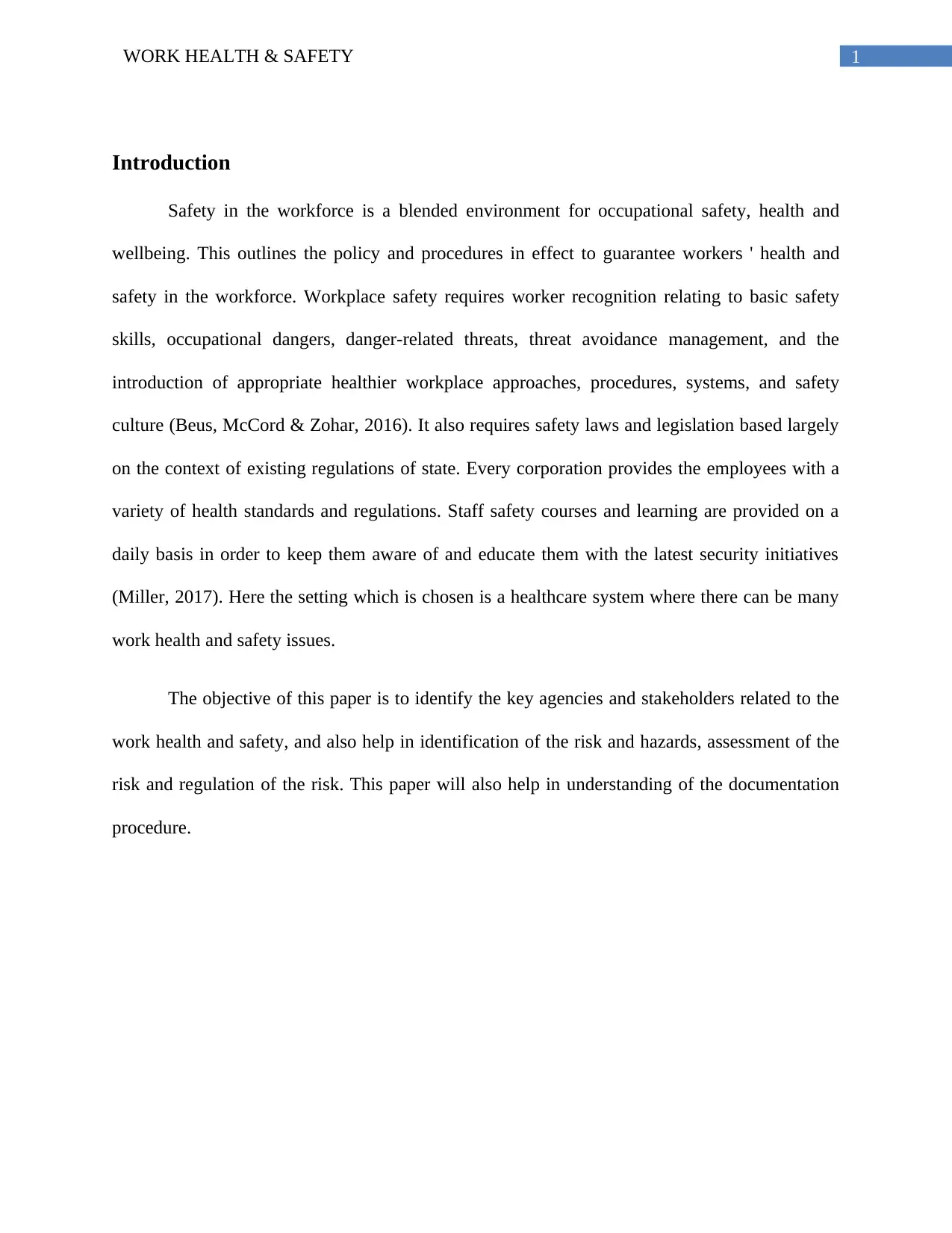
1WORK HEALTH & SAFETY
Introduction
Safety in the workforce is a blended environment for occupational safety, health and
wellbeing. This outlines the policy and procedures in effect to guarantee workers ' health and
safety in the workforce. Workplace safety requires worker recognition relating to basic safety
skills, occupational dangers, danger-related threats, threat avoidance management, and the
introduction of appropriate healthier workplace approaches, procedures, systems, and safety
culture (Beus, McCord & Zohar, 2016). It also requires safety laws and legislation based largely
on the context of existing regulations of state. Every corporation provides the employees with a
variety of health standards and regulations. Staff safety courses and learning are provided on a
daily basis in order to keep them aware of and educate them with the latest security initiatives
(Miller, 2017). Here the setting which is chosen is a healthcare system where there can be many
work health and safety issues.
The objective of this paper is to identify the key agencies and stakeholders related to the
work health and safety, and also help in identification of the risk and hazards, assessment of the
risk and regulation of the risk. This paper will also help in understanding of the documentation
procedure.
Introduction
Safety in the workforce is a blended environment for occupational safety, health and
wellbeing. This outlines the policy and procedures in effect to guarantee workers ' health and
safety in the workforce. Workplace safety requires worker recognition relating to basic safety
skills, occupational dangers, danger-related threats, threat avoidance management, and the
introduction of appropriate healthier workplace approaches, procedures, systems, and safety
culture (Beus, McCord & Zohar, 2016). It also requires safety laws and legislation based largely
on the context of existing regulations of state. Every corporation provides the employees with a
variety of health standards and regulations. Staff safety courses and learning are provided on a
daily basis in order to keep them aware of and educate them with the latest security initiatives
(Miller, 2017). Here the setting which is chosen is a healthcare system where there can be many
work health and safety issues.
The objective of this paper is to identify the key agencies and stakeholders related to the
work health and safety, and also help in identification of the risk and hazards, assessment of the
risk and regulation of the risk. This paper will also help in understanding of the documentation
procedure.
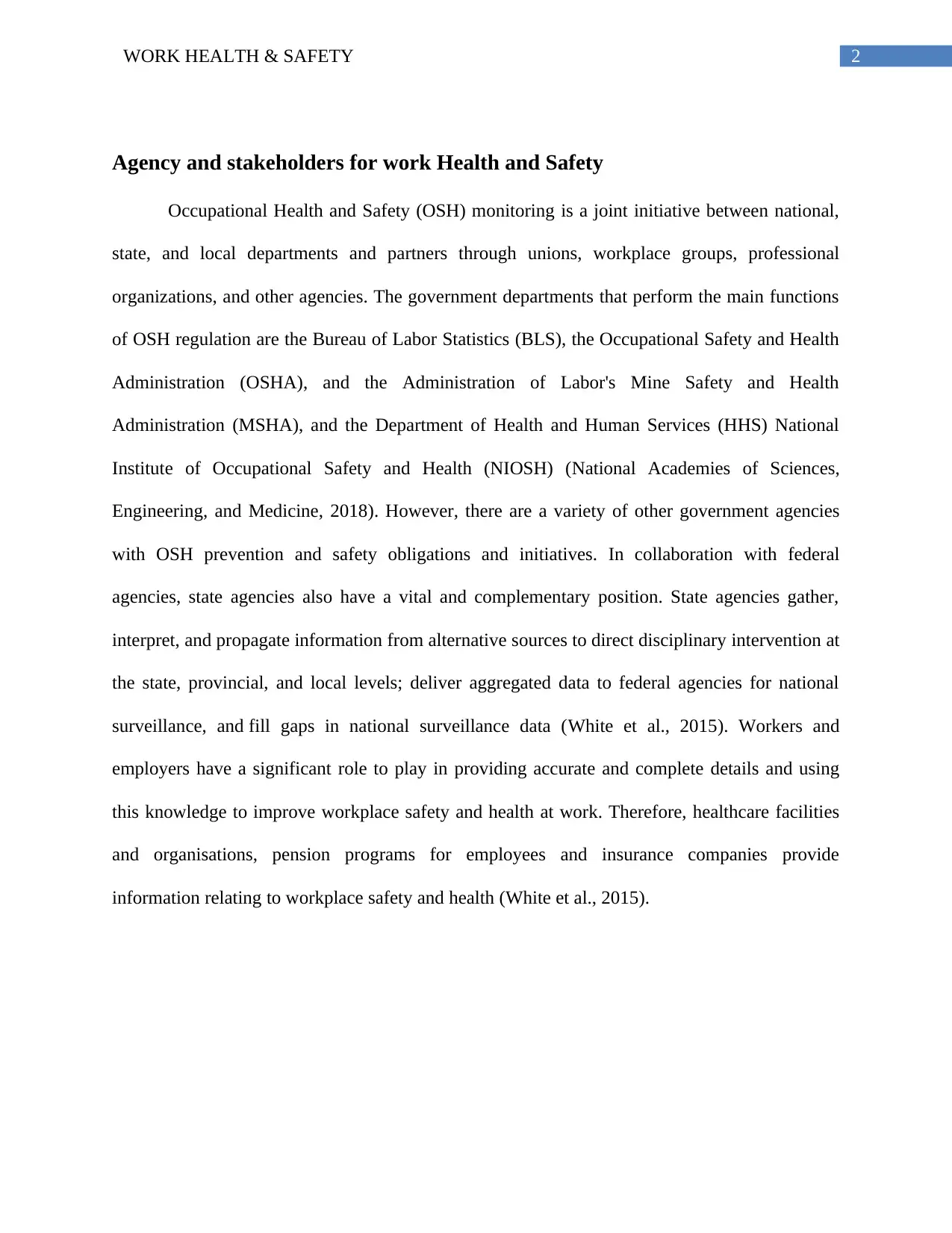
2WORK HEALTH & SAFETY
Agency and stakeholders for work Health and Safety
Occupational Health and Safety (OSH) monitoring is a joint initiative between national,
state, and local departments and partners through unions, workplace groups, professional
organizations, and other agencies. The government departments that perform the main functions
of OSH regulation are the Bureau of Labor Statistics (BLS), the Occupational Safety and Health
Administration (OSHA), and the Administration of Labor's Mine Safety and Health
Administration (MSHA), and the Department of Health and Human Services (HHS) National
Institute of Occupational Safety and Health (NIOSH) (National Academies of Sciences,
Engineering, and Medicine, 2018). However, there are a variety of other government agencies
with OSH prevention and safety obligations and initiatives. In collaboration with federal
agencies, state agencies also have a vital and complementary position. State agencies gather,
interpret, and propagate information from alternative sources to direct disciplinary intervention at
the state, provincial, and local levels; deliver aggregated data to federal agencies for national
surveillance, and fill gaps in national surveillance data (White et al., 2015). Workers and
employers have a significant role to play in providing accurate and complete details and using
this knowledge to improve workplace safety and health at work. Therefore, healthcare facilities
and organisations, pension programs for employees and insurance companies provide
information relating to workplace safety and health (White et al., 2015).
Agency and stakeholders for work Health and Safety
Occupational Health and Safety (OSH) monitoring is a joint initiative between national,
state, and local departments and partners through unions, workplace groups, professional
organizations, and other agencies. The government departments that perform the main functions
of OSH regulation are the Bureau of Labor Statistics (BLS), the Occupational Safety and Health
Administration (OSHA), and the Administration of Labor's Mine Safety and Health
Administration (MSHA), and the Department of Health and Human Services (HHS) National
Institute of Occupational Safety and Health (NIOSH) (National Academies of Sciences,
Engineering, and Medicine, 2018). However, there are a variety of other government agencies
with OSH prevention and safety obligations and initiatives. In collaboration with federal
agencies, state agencies also have a vital and complementary position. State agencies gather,
interpret, and propagate information from alternative sources to direct disciplinary intervention at
the state, provincial, and local levels; deliver aggregated data to federal agencies for national
surveillance, and fill gaps in national surveillance data (White et al., 2015). Workers and
employers have a significant role to play in providing accurate and complete details and using
this knowledge to improve workplace safety and health at work. Therefore, healthcare facilities
and organisations, pension programs for employees and insurance companies provide
information relating to workplace safety and health (White et al., 2015).
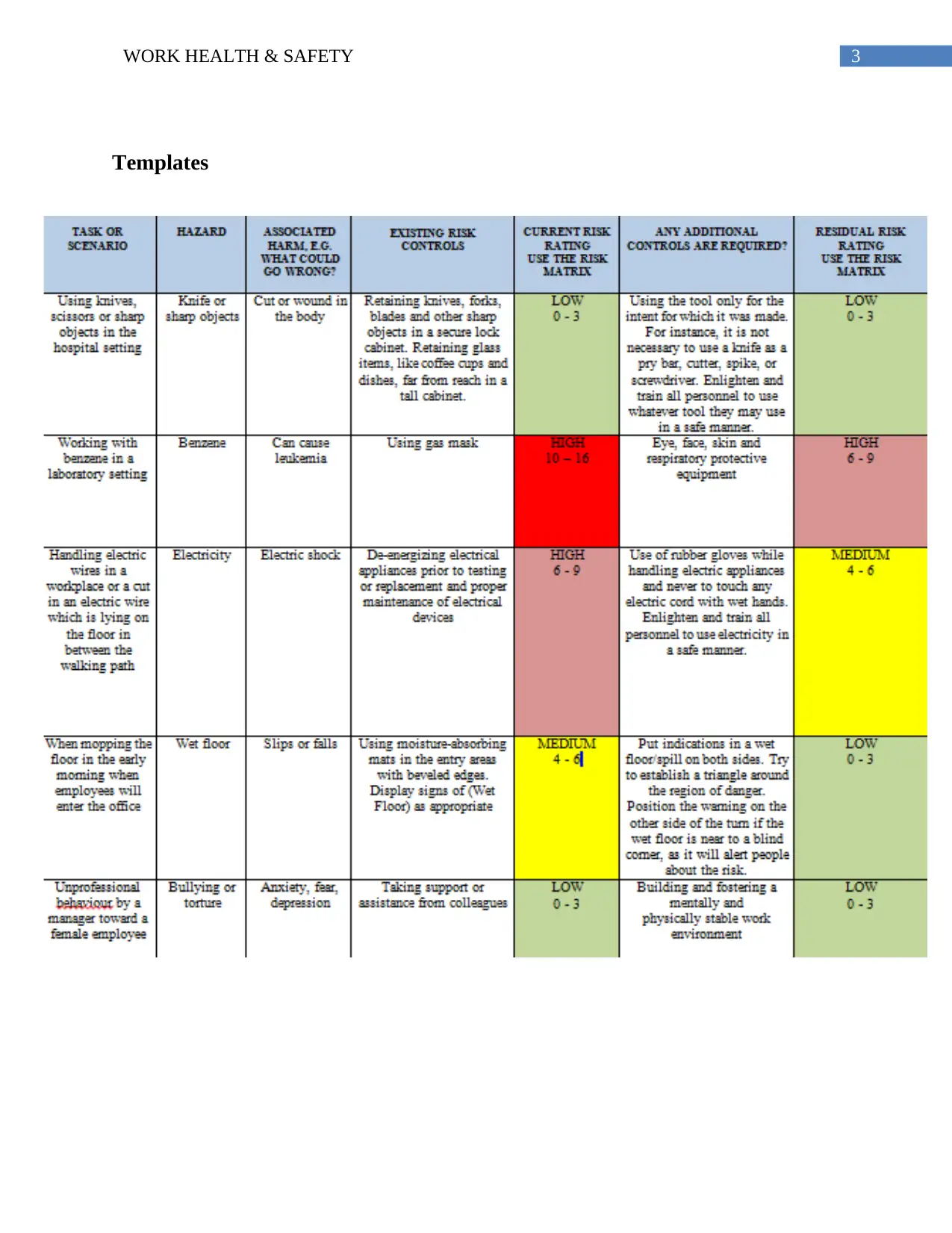
3WORK HEALTH & SAFETY
Templates
Templates
Secure Best Marks with AI Grader
Need help grading? Try our AI Grader for instant feedback on your assignments.
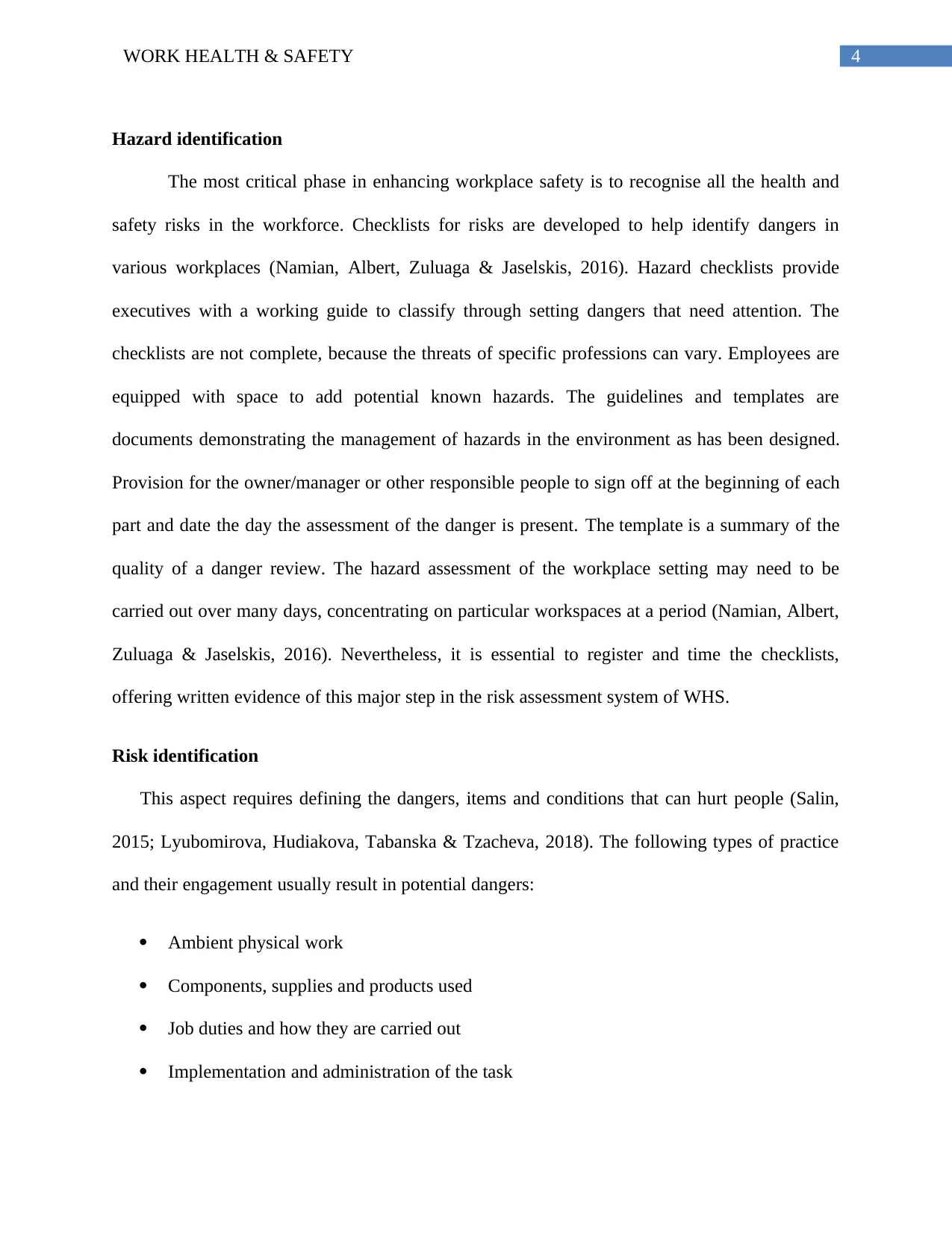
4WORK HEALTH & SAFETY
Hazard identification
The most critical phase in enhancing workplace safety is to recognise all the health and
safety risks in the workforce. Checklists for risks are developed to help identify dangers in
various workplaces (Namian, Albert, Zuluaga & Jaselskis, 2016). Hazard checklists provide
executives with a working guide to classify through setting dangers that need attention. The
checklists are not complete, because the threats of specific professions can vary. Employees are
equipped with space to add potential known hazards. The guidelines and templates are
documents demonstrating the management of hazards in the environment as has been designed.
Provision for the owner/manager or other responsible people to sign off at the beginning of each
part and date the day the assessment of the danger is present. The template is a summary of the
quality of a danger review. The hazard assessment of the workplace setting may need to be
carried out over many days, concentrating on particular workspaces at a period (Namian, Albert,
Zuluaga & Jaselskis, 2016). Nevertheless, it is essential to register and time the checklists,
offering written evidence of this major step in the risk assessment system of WHS.
Risk identification
This aspect requires defining the dangers, items and conditions that can hurt people (Salin,
2015; Lyubomirova, Hudiakova, Tabanska & Tzacheva, 2018). The following types of practice
and their engagement usually result in potential dangers:
Ambient physical work
Components, supplies and products used
Job duties and how they are carried out
Implementation and administration of the task
Hazard identification
The most critical phase in enhancing workplace safety is to recognise all the health and
safety risks in the workforce. Checklists for risks are developed to help identify dangers in
various workplaces (Namian, Albert, Zuluaga & Jaselskis, 2016). Hazard checklists provide
executives with a working guide to classify through setting dangers that need attention. The
checklists are not complete, because the threats of specific professions can vary. Employees are
equipped with space to add potential known hazards. The guidelines and templates are
documents demonstrating the management of hazards in the environment as has been designed.
Provision for the owner/manager or other responsible people to sign off at the beginning of each
part and date the day the assessment of the danger is present. The template is a summary of the
quality of a danger review. The hazard assessment of the workplace setting may need to be
carried out over many days, concentrating on particular workspaces at a period (Namian, Albert,
Zuluaga & Jaselskis, 2016). Nevertheless, it is essential to register and time the checklists,
offering written evidence of this major step in the risk assessment system of WHS.
Risk identification
This aspect requires defining the dangers, items and conditions that can hurt people (Salin,
2015; Lyubomirova, Hudiakova, Tabanska & Tzacheva, 2018). The following types of practice
and their engagement usually result in potential dangers:
Ambient physical work
Components, supplies and products used
Job duties and how they are carried out
Implementation and administration of the task
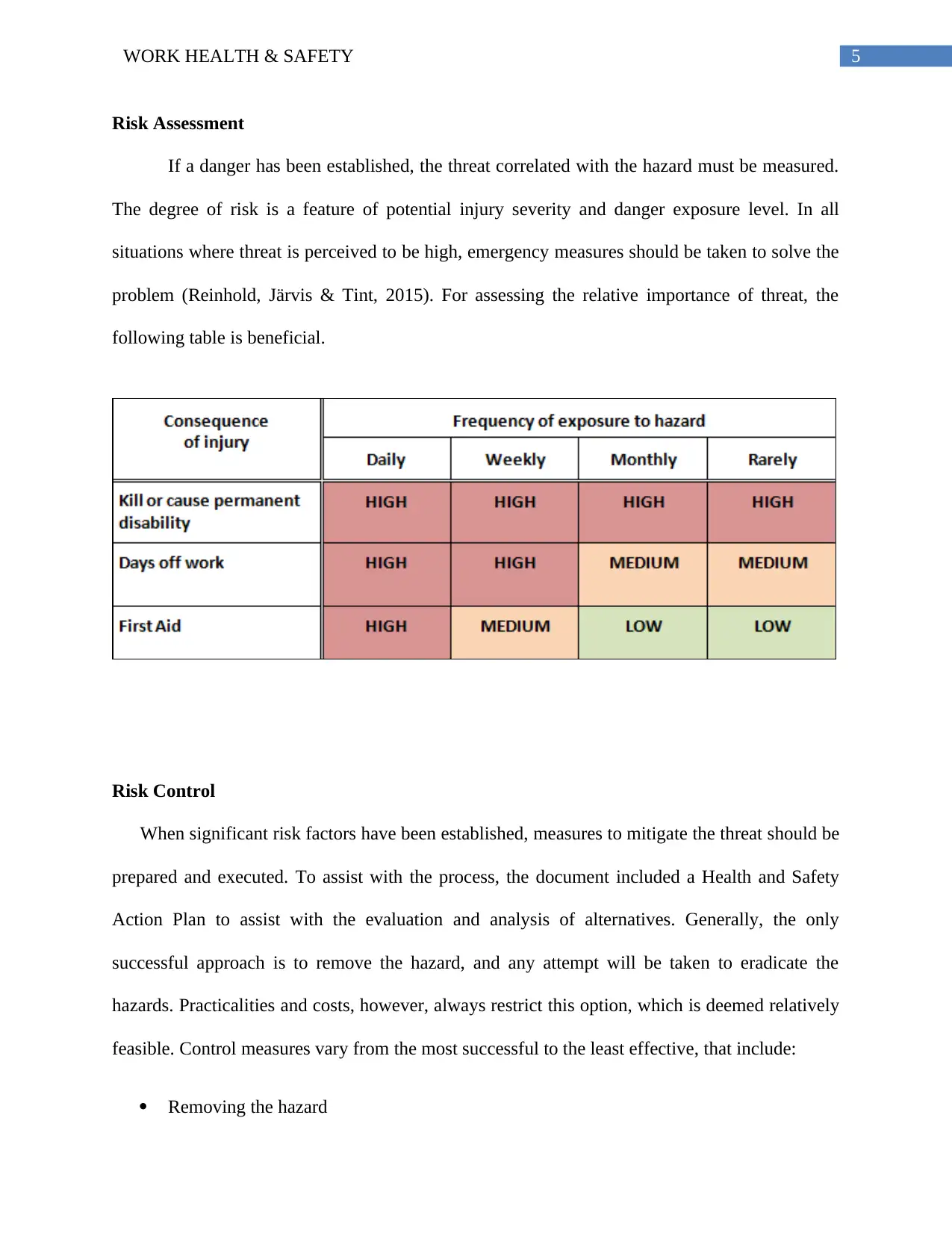
5WORK HEALTH & SAFETY
Risk Assessment
If a danger has been established, the threat correlated with the hazard must be measured.
The degree of risk is a feature of potential injury severity and danger exposure level. In all
situations where threat is perceived to be high, emergency measures should be taken to solve the
problem (Reinhold, Järvis & Tint, 2015). For assessing the relative importance of threat, the
following table is beneficial.
Risk Control
When significant risk factors have been established, measures to mitigate the threat should be
prepared and executed. To assist with the process, the document included a Health and Safety
Action Plan to assist with the evaluation and analysis of alternatives. Generally, the only
successful approach is to remove the hazard, and any attempt will be taken to eradicate the
hazards. Practicalities and costs, however, always restrict this option, which is deemed relatively
feasible. Control measures vary from the most successful to the least effective, that include:
Removing the hazard
Risk Assessment
If a danger has been established, the threat correlated with the hazard must be measured.
The degree of risk is a feature of potential injury severity and danger exposure level. In all
situations where threat is perceived to be high, emergency measures should be taken to solve the
problem (Reinhold, Järvis & Tint, 2015). For assessing the relative importance of threat, the
following table is beneficial.
Risk Control
When significant risk factors have been established, measures to mitigate the threat should be
prepared and executed. To assist with the process, the document included a Health and Safety
Action Plan to assist with the evaluation and analysis of alternatives. Generally, the only
successful approach is to remove the hazard, and any attempt will be taken to eradicate the
hazards. Practicalities and costs, however, always restrict this option, which is deemed relatively
feasible. Control measures vary from the most successful to the least effective, that include:
Removing the hazard
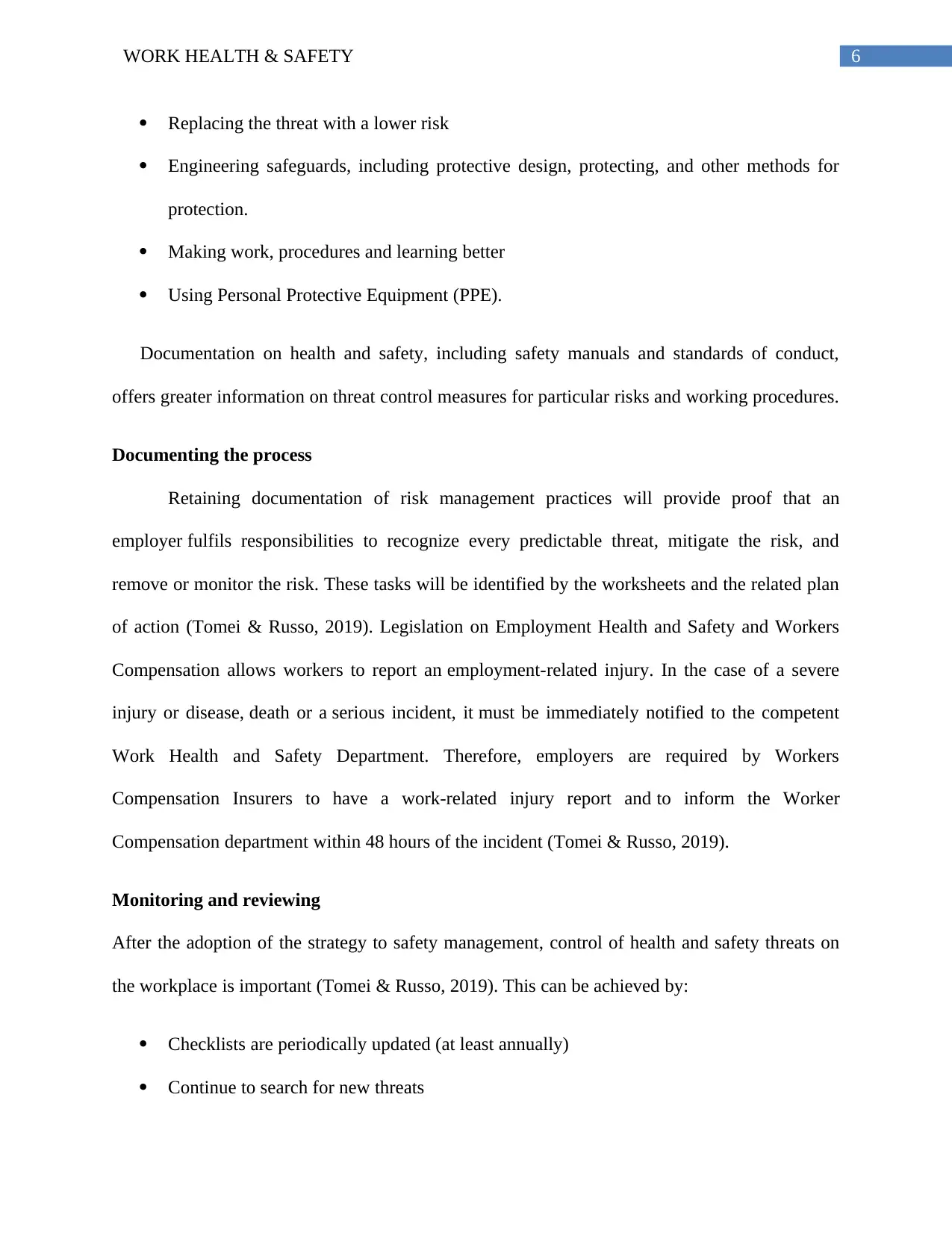
6WORK HEALTH & SAFETY
Replacing the threat with a lower risk
Engineering safeguards, including protective design, protecting, and other methods for
protection.
Making work, procedures and learning better
Using Personal Protective Equipment (PPE).
Documentation on health and safety, including safety manuals and standards of conduct,
offers greater information on threat control measures for particular risks and working procedures.
Documenting the process
Retaining documentation of risk management practices will provide proof that an
employer fulfils responsibilities to recognize every predictable threat, mitigate the risk, and
remove or monitor the risk. These tasks will be identified by the worksheets and the related plan
of action (Tomei & Russo, 2019). Legislation on Employment Health and Safety and Workers
Compensation allows workers to report an employment-related injury. In the case of a severe
injury or disease, death or a serious incident, it must be immediately notified to the competent
Work Health and Safety Department. Therefore, employers are required by Workers
Compensation Insurers to have a work-related injury report and to inform the Worker
Compensation department within 48 hours of the incident (Tomei & Russo, 2019).
Monitoring and reviewing
After the adoption of the strategy to safety management, control of health and safety threats on
the workplace is important (Tomei & Russo, 2019). This can be achieved by:
Checklists are periodically updated (at least annually)
Continue to search for new threats
Replacing the threat with a lower risk
Engineering safeguards, including protective design, protecting, and other methods for
protection.
Making work, procedures and learning better
Using Personal Protective Equipment (PPE).
Documentation on health and safety, including safety manuals and standards of conduct,
offers greater information on threat control measures for particular risks and working procedures.
Documenting the process
Retaining documentation of risk management practices will provide proof that an
employer fulfils responsibilities to recognize every predictable threat, mitigate the risk, and
remove or monitor the risk. These tasks will be identified by the worksheets and the related plan
of action (Tomei & Russo, 2019). Legislation on Employment Health and Safety and Workers
Compensation allows workers to report an employment-related injury. In the case of a severe
injury or disease, death or a serious incident, it must be immediately notified to the competent
Work Health and Safety Department. Therefore, employers are required by Workers
Compensation Insurers to have a work-related injury report and to inform the Worker
Compensation department within 48 hours of the incident (Tomei & Russo, 2019).
Monitoring and reviewing
After the adoption of the strategy to safety management, control of health and safety threats on
the workplace is important (Tomei & Russo, 2019). This can be achieved by:
Checklists are periodically updated (at least annually)
Continue to search for new threats
Paraphrase This Document
Need a fresh take? Get an instant paraphrase of this document with our AI Paraphraser
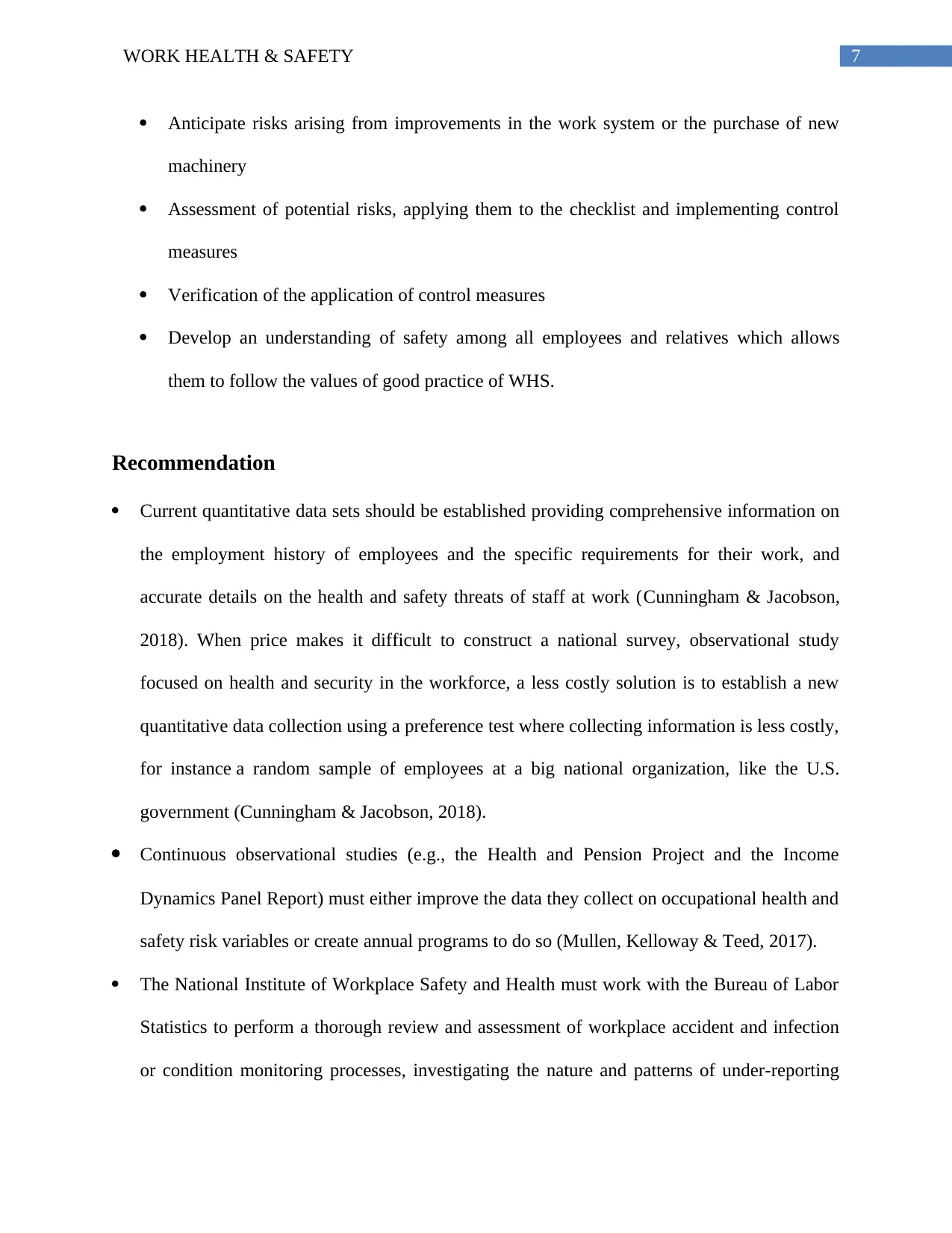
7WORK HEALTH & SAFETY
Anticipate risks arising from improvements in the work system or the purchase of new
machinery
Assessment of potential risks, applying them to the checklist and implementing control
measures
Verification of the application of control measures
Develop an understanding of safety among all employees and relatives which allows
them to follow the values of good practice of WHS.
Recommendation
Current quantitative data sets should be established providing comprehensive information on
the employment history of employees and the specific requirements for their work, and
accurate details on the health and safety threats of staff at work (Cunningham & Jacobson,
2018). When price makes it difficult to construct a national survey, observational study
focused on health and security in the workforce, a less costly solution is to establish a new
quantitative data collection using a preference test where collecting information is less costly,
for instance a random sample of employees at a big national organization, like the U.S.
government (Cunningham & Jacobson, 2018).
Continuous observational studies (e.g., the Health and Pension Project and the Income
Dynamics Panel Report) must either improve the data they collect on occupational health and
safety risk variables or create annual programs to do so (Mullen, Kelloway & Teed, 2017).
The National Institute of Workplace Safety and Health must work with the Bureau of Labor
Statistics to perform a thorough review and assessment of workplace accident and infection
or condition monitoring processes, investigating the nature and patterns of under-reporting
Anticipate risks arising from improvements in the work system or the purchase of new
machinery
Assessment of potential risks, applying them to the checklist and implementing control
measures
Verification of the application of control measures
Develop an understanding of safety among all employees and relatives which allows
them to follow the values of good practice of WHS.
Recommendation
Current quantitative data sets should be established providing comprehensive information on
the employment history of employees and the specific requirements for their work, and
accurate details on the health and safety threats of staff at work (Cunningham & Jacobson,
2018). When price makes it difficult to construct a national survey, observational study
focused on health and security in the workforce, a less costly solution is to establish a new
quantitative data collection using a preference test where collecting information is less costly,
for instance a random sample of employees at a big national organization, like the U.S.
government (Cunningham & Jacobson, 2018).
Continuous observational studies (e.g., the Health and Pension Project and the Income
Dynamics Panel Report) must either improve the data they collect on occupational health and
safety risk variables or create annual programs to do so (Mullen, Kelloway & Teed, 2017).
The National Institute of Workplace Safety and Health must work with the Bureau of Labor
Statistics to perform a thorough review and assessment of workplace accident and infection
or condition monitoring processes, investigating the nature and patterns of under-reporting
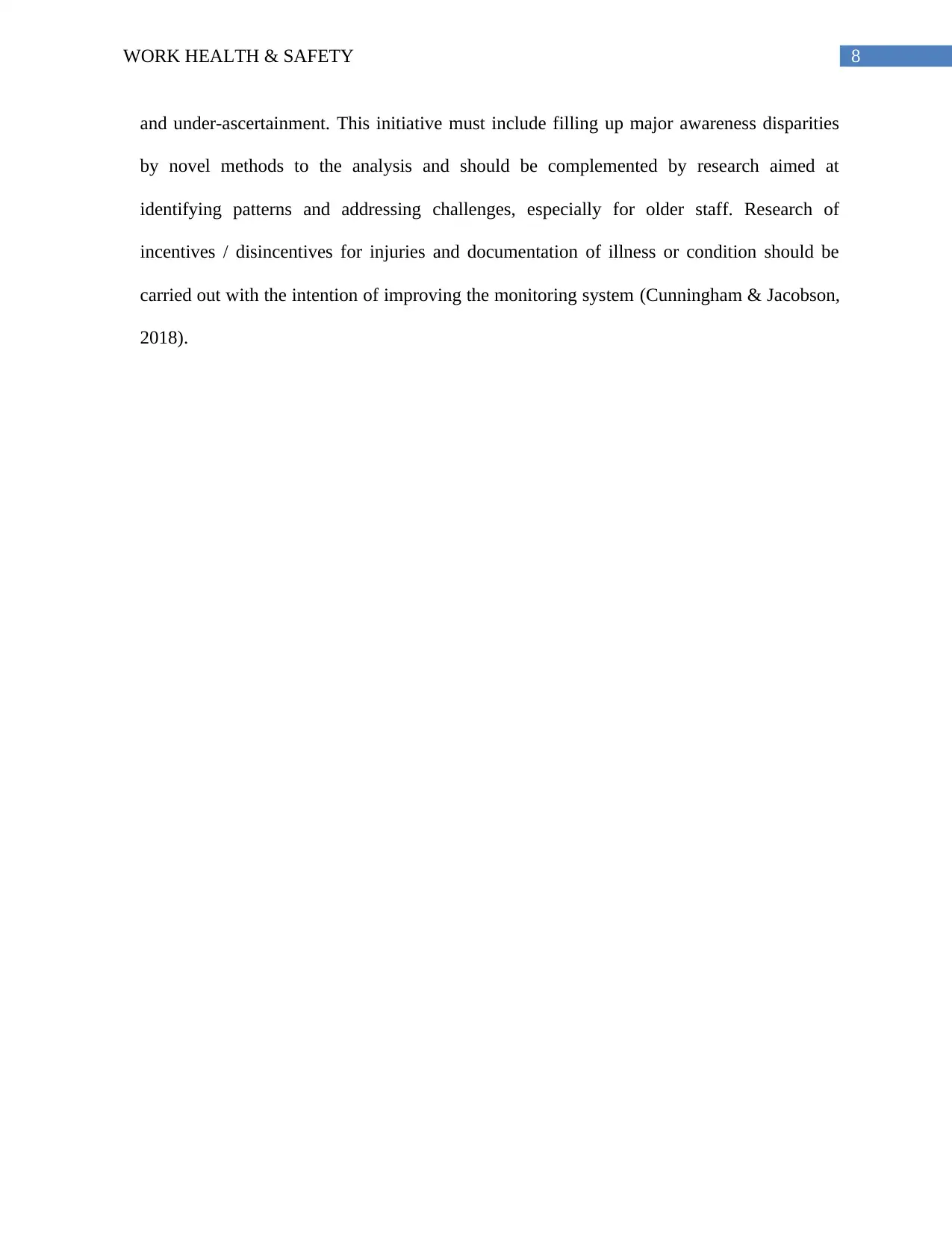
8WORK HEALTH & SAFETY
and under-ascertainment. This initiative must include filling up major awareness disparities
by novel methods to the analysis and should be complemented by research aimed at
identifying patterns and addressing challenges, especially for older staff. Research of
incentives / disincentives for injuries and documentation of illness or condition should be
carried out with the intention of improving the monitoring system (Cunningham & Jacobson,
2018).
and under-ascertainment. This initiative must include filling up major awareness disparities
by novel methods to the analysis and should be complemented by research aimed at
identifying patterns and addressing challenges, especially for older staff. Research of
incentives / disincentives for injuries and documentation of illness or condition should be
carried out with the intention of improving the monitoring system (Cunningham & Jacobson,
2018).
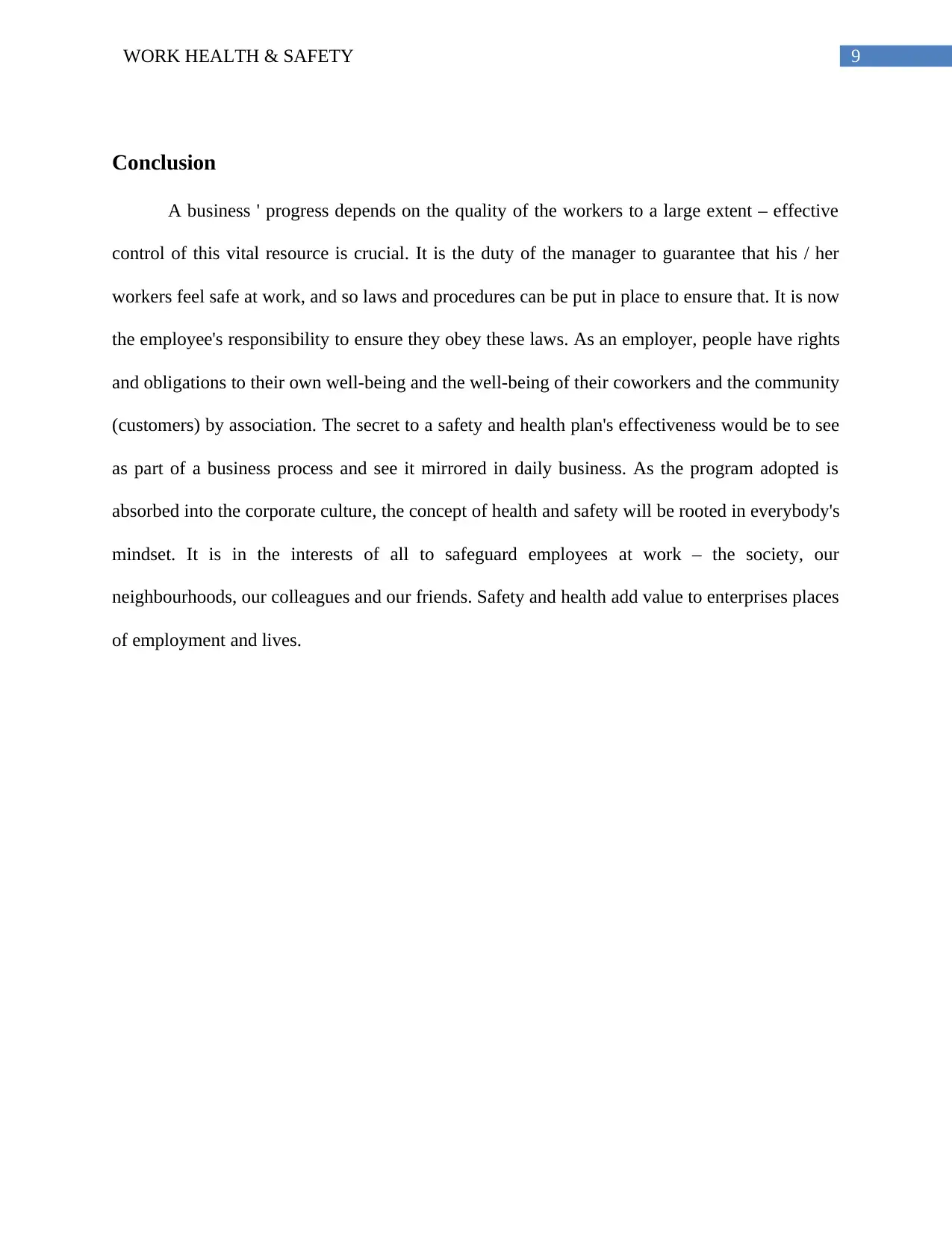
9WORK HEALTH & SAFETY
Conclusion
A business ' progress depends on the quality of the workers to a large extent – effective
control of this vital resource is crucial. It is the duty of the manager to guarantee that his / her
workers feel safe at work, and so laws and procedures can be put in place to ensure that. It is now
the employee's responsibility to ensure they obey these laws. As an employer, people have rights
and obligations to their own well-being and the well-being of their coworkers and the community
(customers) by association. The secret to a safety and health plan's effectiveness would be to see
as part of a business process and see it mirrored in daily business. As the program adopted is
absorbed into the corporate culture, the concept of health and safety will be rooted in everybody's
mindset. It is in the interests of all to safeguard employees at work – the society, our
neighbourhoods, our colleagues and our friends. Safety and health add value to enterprises places
of employment and lives.
Conclusion
A business ' progress depends on the quality of the workers to a large extent – effective
control of this vital resource is crucial. It is the duty of the manager to guarantee that his / her
workers feel safe at work, and so laws and procedures can be put in place to ensure that. It is now
the employee's responsibility to ensure they obey these laws. As an employer, people have rights
and obligations to their own well-being and the well-being of their coworkers and the community
(customers) by association. The secret to a safety and health plan's effectiveness would be to see
as part of a business process and see it mirrored in daily business. As the program adopted is
absorbed into the corporate culture, the concept of health and safety will be rooted in everybody's
mindset. It is in the interests of all to safeguard employees at work – the society, our
neighbourhoods, our colleagues and our friends. Safety and health add value to enterprises places
of employment and lives.
Secure Best Marks with AI Grader
Need help grading? Try our AI Grader for instant feedback on your assignments.
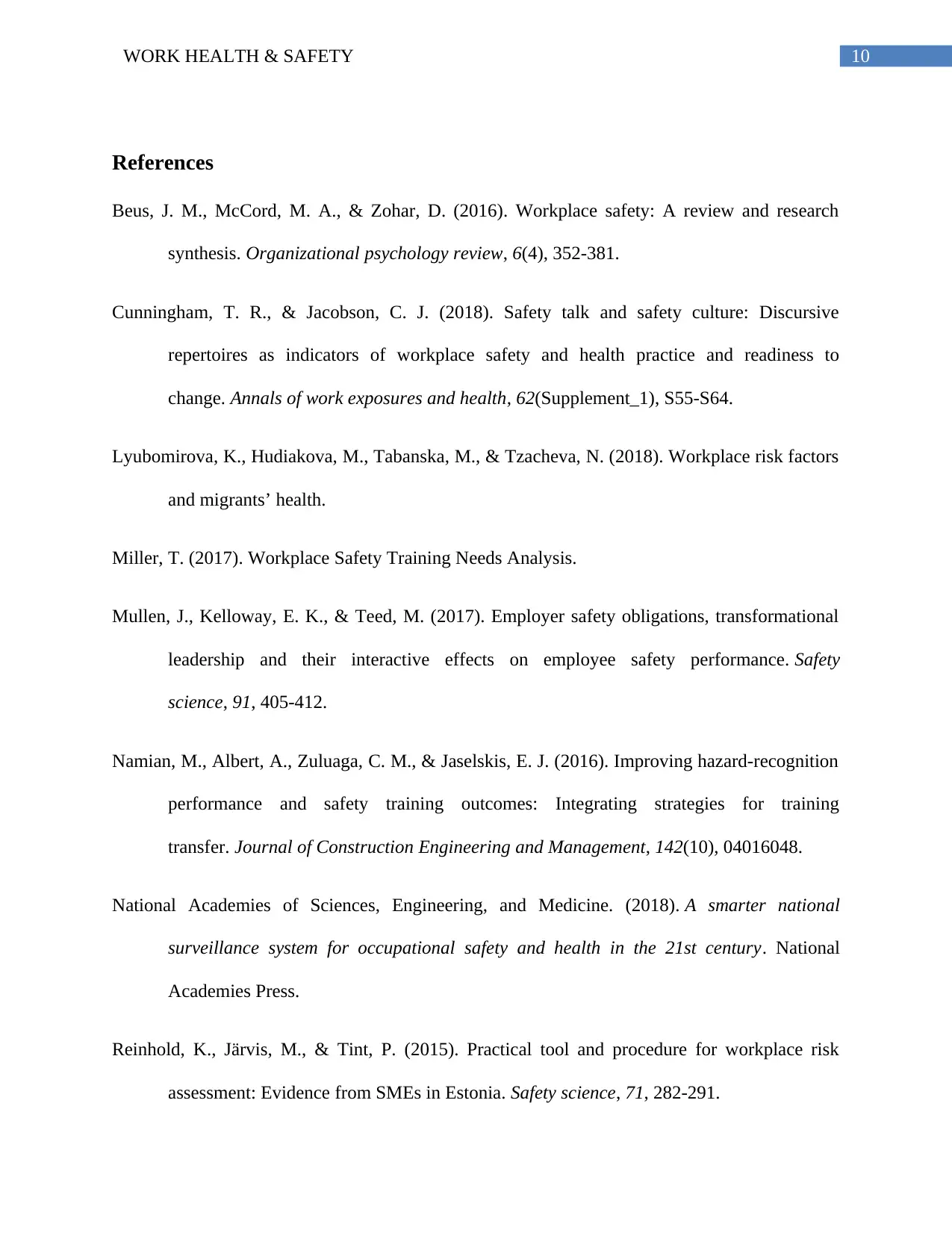
10WORK HEALTH & SAFETY
References
Beus, J. M., McCord, M. A., & Zohar, D. (2016). Workplace safety: A review and research
synthesis. Organizational psychology review, 6(4), 352-381.
Cunningham, T. R., & Jacobson, C. J. (2018). Safety talk and safety culture: Discursive
repertoires as indicators of workplace safety and health practice and readiness to
change. Annals of work exposures and health, 62(Supplement_1), S55-S64.
Lyubomirova, K., Hudiakova, M., Tabanska, M., & Tzacheva, N. (2018). Workplace risk factors
and migrants’ health.
Miller, T. (2017). Workplace Safety Training Needs Analysis.
Mullen, J., Kelloway, E. K., & Teed, M. (2017). Employer safety obligations, transformational
leadership and their interactive effects on employee safety performance. Safety
science, 91, 405-412.
Namian, M., Albert, A., Zuluaga, C. M., & Jaselskis, E. J. (2016). Improving hazard-recognition
performance and safety training outcomes: Integrating strategies for training
transfer. Journal of Construction Engineering and Management, 142(10), 04016048.
National Academies of Sciences, Engineering, and Medicine. (2018). A smarter national
surveillance system for occupational safety and health in the 21st century. National
Academies Press.
Reinhold, K., Järvis, M., & Tint, P. (2015). Practical tool and procedure for workplace risk
assessment: Evidence from SMEs in Estonia. Safety science, 71, 282-291.
References
Beus, J. M., McCord, M. A., & Zohar, D. (2016). Workplace safety: A review and research
synthesis. Organizational psychology review, 6(4), 352-381.
Cunningham, T. R., & Jacobson, C. J. (2018). Safety talk and safety culture: Discursive
repertoires as indicators of workplace safety and health practice and readiness to
change. Annals of work exposures and health, 62(Supplement_1), S55-S64.
Lyubomirova, K., Hudiakova, M., Tabanska, M., & Tzacheva, N. (2018). Workplace risk factors
and migrants’ health.
Miller, T. (2017). Workplace Safety Training Needs Analysis.
Mullen, J., Kelloway, E. K., & Teed, M. (2017). Employer safety obligations, transformational
leadership and their interactive effects on employee safety performance. Safety
science, 91, 405-412.
Namian, M., Albert, A., Zuluaga, C. M., & Jaselskis, E. J. (2016). Improving hazard-recognition
performance and safety training outcomes: Integrating strategies for training
transfer. Journal of Construction Engineering and Management, 142(10), 04016048.
National Academies of Sciences, Engineering, and Medicine. (2018). A smarter national
surveillance system for occupational safety and health in the 21st century. National
Academies Press.
Reinhold, K., Järvis, M., & Tint, P. (2015). Practical tool and procedure for workplace risk
assessment: Evidence from SMEs in Estonia. Safety science, 71, 282-291.
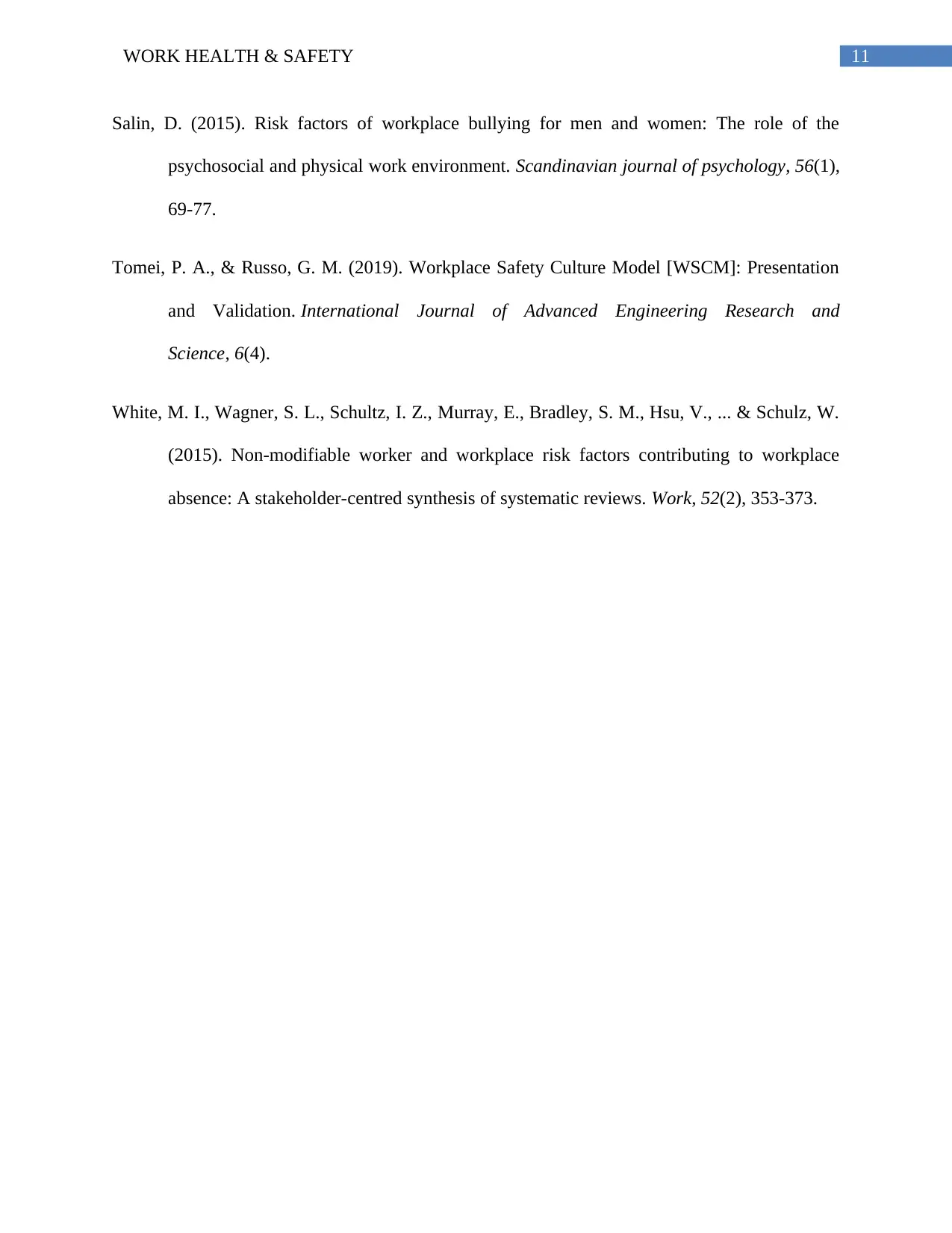
11WORK HEALTH & SAFETY
Salin, D. (2015). Risk factors of workplace bullying for men and women: The role of the
psychosocial and physical work environment. Scandinavian journal of psychology, 56(1),
69-77.
Tomei, P. A., & Russo, G. M. (2019). Workplace Safety Culture Model [WSCM]: Presentation
and Validation. International Journal of Advanced Engineering Research and
Science, 6(4).
White, M. I., Wagner, S. L., Schultz, I. Z., Murray, E., Bradley, S. M., Hsu, V., ... & Schulz, W.
(2015). Non-modifiable worker and workplace risk factors contributing to workplace
absence: A stakeholder-centred synthesis of systematic reviews. Work, 52(2), 353-373.
Salin, D. (2015). Risk factors of workplace bullying for men and women: The role of the
psychosocial and physical work environment. Scandinavian journal of psychology, 56(1),
69-77.
Tomei, P. A., & Russo, G. M. (2019). Workplace Safety Culture Model [WSCM]: Presentation
and Validation. International Journal of Advanced Engineering Research and
Science, 6(4).
White, M. I., Wagner, S. L., Schultz, I. Z., Murray, E., Bradley, S. M., Hsu, V., ... & Schulz, W.
(2015). Non-modifiable worker and workplace risk factors contributing to workplace
absence: A stakeholder-centred synthesis of systematic reviews. Work, 52(2), 353-373.
1 out of 12
Related Documents
Your All-in-One AI-Powered Toolkit for Academic Success.
+13062052269
info@desklib.com
Available 24*7 on WhatsApp / Email
![[object Object]](/_next/static/media/star-bottom.7253800d.svg)
Unlock your academic potential
© 2024 | Zucol Services PVT LTD | All rights reserved.





